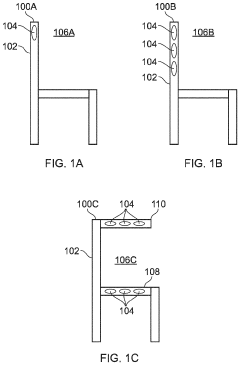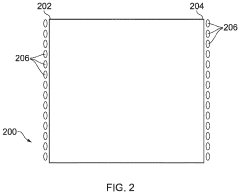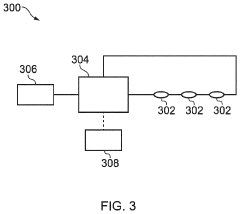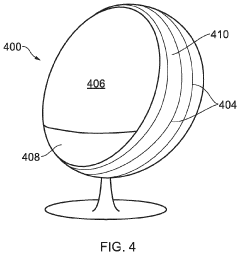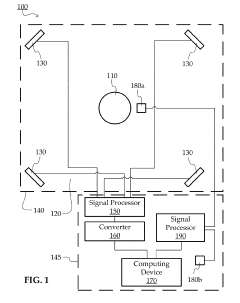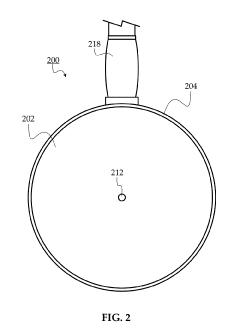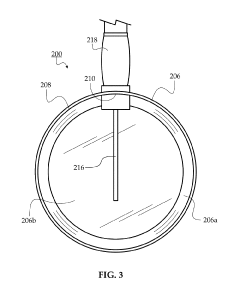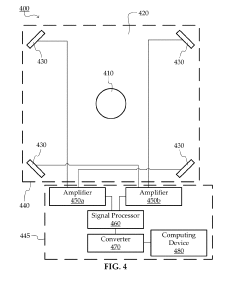Schumann Resonance: A Dynamic Natural Radio Signal
JUN 24, 20259 MIN READ
Generate Your Research Report Instantly with AI Agent
Patsnap Eureka helps you evaluate technical feasibility & market potential.
Schumann Resonance Background and Research Objectives
Schumann resonances, discovered by physicist Winfried Otto Schumann in 1952, are a set of spectrum peaks in the extremely low frequency (ELF) portion of the Earth's electromagnetic field spectrum. These resonances occur in the Earth-ionosphere cavity, a natural waveguide formed between the Earth's surface and the ionosphere. The fundamental frequency of Schumann resonances is approximately 7.83 Hz, with harmonics at higher frequencies.
The study of Schumann resonances has evolved significantly since their discovery, encompassing various scientific disciplines including atmospheric physics, geophysics, and space weather research. Initially considered a curiosity, these resonances have gained importance in understanding global electromagnetic phenomena and their potential impacts on Earth's systems.
Research objectives in the field of Schumann resonances have expanded over time, driven by advancements in technology and growing awareness of their significance. Current research aims to explore the relationship between Schumann resonances and various geophysical and atmospheric processes, including climate change, lightning activity, and ionospheric dynamics.
One primary objective is to develop more accurate models of the Earth-ionosphere cavity and improve our understanding of the factors influencing Schumann resonance characteristics. This includes investigating how solar activity, geomagnetic storms, and other space weather events affect the resonances' amplitude, frequency, and phase.
Another key research goal is to explore the potential applications of Schumann resonance measurements in various fields. For instance, researchers are investigating their use as a global lightning activity indicator, a tool for monitoring the Earth's climate, and a potential method for early earthquake detection.
The development of more sensitive and reliable measurement techniques is also a crucial objective in Schumann resonance research. This involves designing advanced sensors and signal processing algorithms to detect and analyze these weak natural radio signals amidst increasing electromagnetic noise from human activities.
Furthermore, scientists are exploring the possible biological effects of Schumann resonances, including their potential influence on human health and circadian rhythms. This interdisciplinary research combines physics, biology, and medical science to investigate the interactions between natural electromagnetic fields and living organisms.
As technology continues to advance, researchers are also focusing on integrating Schumann resonance measurements with other geophysical and space weather monitoring systems. This holistic approach aims to enhance our understanding of the Earth's electromagnetic environment and its interactions with various natural phenomena.
The study of Schumann resonances has evolved significantly since their discovery, encompassing various scientific disciplines including atmospheric physics, geophysics, and space weather research. Initially considered a curiosity, these resonances have gained importance in understanding global electromagnetic phenomena and their potential impacts on Earth's systems.
Research objectives in the field of Schumann resonances have expanded over time, driven by advancements in technology and growing awareness of their significance. Current research aims to explore the relationship between Schumann resonances and various geophysical and atmospheric processes, including climate change, lightning activity, and ionospheric dynamics.
One primary objective is to develop more accurate models of the Earth-ionosphere cavity and improve our understanding of the factors influencing Schumann resonance characteristics. This includes investigating how solar activity, geomagnetic storms, and other space weather events affect the resonances' amplitude, frequency, and phase.
Another key research goal is to explore the potential applications of Schumann resonance measurements in various fields. For instance, researchers are investigating their use as a global lightning activity indicator, a tool for monitoring the Earth's climate, and a potential method for early earthquake detection.
The development of more sensitive and reliable measurement techniques is also a crucial objective in Schumann resonance research. This involves designing advanced sensors and signal processing algorithms to detect and analyze these weak natural radio signals amidst increasing electromagnetic noise from human activities.
Furthermore, scientists are exploring the possible biological effects of Schumann resonances, including their potential influence on human health and circadian rhythms. This interdisciplinary research combines physics, biology, and medical science to investigate the interactions between natural electromagnetic fields and living organisms.
As technology continues to advance, researchers are also focusing on integrating Schumann resonance measurements with other geophysical and space weather monitoring systems. This holistic approach aims to enhance our understanding of the Earth's electromagnetic environment and its interactions with various natural phenomena.
Market Applications of Schumann Resonance Technology
Schumann Resonance technology has found diverse applications across various market sectors, leveraging its unique properties as a natural electromagnetic phenomenon. In the field of geophysics and earth monitoring, Schumann Resonance measurements are utilized to study global lightning activity, climate change effects, and ionospheric dynamics. This data aids in improving weather forecasting models and understanding long-term climate trends.
The healthcare industry has shown increasing interest in Schumann Resonance applications. Some researchers propose that exposure to these natural frequencies may have beneficial effects on human health, potentially influencing circadian rhythms and overall well-being. This has led to the development of wellness products and therapies that aim to replicate or enhance exposure to Schumann Resonances, although scientific consensus on their efficacy remains limited.
In the realm of telecommunications and navigation, Schumann Resonance technology offers potential for long-range, low-frequency communication systems. These could be particularly valuable in scenarios where traditional radio communication is challenging, such as underwater or underground environments. Additionally, some researchers are exploring the use of Schumann Resonances as a natural timing mechanism for global positioning systems, potentially enhancing the accuracy of existing GPS technologies.
The aerospace industry has also found applications for Schumann Resonance technology. Space weather monitoring systems utilize Schumann Resonance data to detect solar activity and predict geomagnetic storms, which can impact satellite operations and power grids. This information is crucial for safeguarding critical infrastructure and ensuring the reliability of space-based technologies.
In the field of natural disaster prediction, Schumann Resonance measurements are being investigated as a potential early warning system for earthquakes and other seismic activities. While still in the research phase, this application could have significant implications for disaster preparedness and risk mitigation in earthquake-prone regions.
The energy sector is exploring Schumann Resonance technology for its potential in wireless power transmission. Researchers are investigating methods to harness these natural electromagnetic waves for long-distance, low-loss energy transfer, which could revolutionize power distribution systems and enable new forms of renewable energy harvesting.
As environmental monitoring becomes increasingly critical, Schumann Resonance technology is being integrated into global observation networks. These systems provide valuable data on atmospheric electricity, ionospheric conditions, and global electromagnetic activity, contributing to our understanding of Earth's complex environmental systems and supporting climate research initiatives.
The healthcare industry has shown increasing interest in Schumann Resonance applications. Some researchers propose that exposure to these natural frequencies may have beneficial effects on human health, potentially influencing circadian rhythms and overall well-being. This has led to the development of wellness products and therapies that aim to replicate or enhance exposure to Schumann Resonances, although scientific consensus on their efficacy remains limited.
In the realm of telecommunications and navigation, Schumann Resonance technology offers potential for long-range, low-frequency communication systems. These could be particularly valuable in scenarios where traditional radio communication is challenging, such as underwater or underground environments. Additionally, some researchers are exploring the use of Schumann Resonances as a natural timing mechanism for global positioning systems, potentially enhancing the accuracy of existing GPS technologies.
The aerospace industry has also found applications for Schumann Resonance technology. Space weather monitoring systems utilize Schumann Resonance data to detect solar activity and predict geomagnetic storms, which can impact satellite operations and power grids. This information is crucial for safeguarding critical infrastructure and ensuring the reliability of space-based technologies.
In the field of natural disaster prediction, Schumann Resonance measurements are being investigated as a potential early warning system for earthquakes and other seismic activities. While still in the research phase, this application could have significant implications for disaster preparedness and risk mitigation in earthquake-prone regions.
The energy sector is exploring Schumann Resonance technology for its potential in wireless power transmission. Researchers are investigating methods to harness these natural electromagnetic waves for long-distance, low-loss energy transfer, which could revolutionize power distribution systems and enable new forms of renewable energy harvesting.
As environmental monitoring becomes increasingly critical, Schumann Resonance technology is being integrated into global observation networks. These systems provide valuable data on atmospheric electricity, ionospheric conditions, and global electromagnetic activity, contributing to our understanding of Earth's complex environmental systems and supporting climate research initiatives.
Current State and Challenges in Schumann Resonance Detection
The current state of Schumann Resonance detection has seen significant advancements in recent years, yet it continues to face several challenges. Globally, researchers have established a network of monitoring stations equipped with sensitive magnetometers and antennas to capture these low-frequency electromagnetic waves. These stations, spread across various continents, provide valuable data for studying global lightning activity, ionospheric conditions, and potential correlations with geophysical phenomena.
One of the primary challenges in Schumann Resonance detection is the low signal-to-noise ratio. The resonances occur at extremely low frequencies (ELF) ranging from 7.83 Hz to about 60 Hz, which are easily masked by anthropogenic electromagnetic noise, particularly in urban areas. This necessitates the placement of detection equipment in remote locations, often far from power grids and human activity, to minimize interference.
Another significant challenge is the need for highly sensitive and stable instrumentation. The magnetic component of Schumann Resonances is typically in the range of a few picoteslas, requiring magnetometers with exceptional sensitivity and long-term stability. Maintaining the calibration and reliability of these instruments over extended periods is crucial for obtaining consistent and comparable data across different monitoring stations.
Data processing and interpretation present additional challenges. The Schumann Resonance signal is not constant and can be influenced by various factors such as solar activity, seasonal changes, and local weather conditions. Developing robust algorithms to extract meaningful information from the raw data and distinguish between different sources of variation is an ongoing area of research.
The global nature of Schumann Resonances also poses challenges in terms of data integration and collaboration. Coordinating measurements from multiple stations around the world and standardizing data formats and analysis methods are essential for comprehensive studies. This requires international cooperation and the establishment of shared protocols and databases.
Furthermore, the relationship between Schumann Resonances and other geophysical phenomena is not fully understood. While correlations have been observed with phenomena such as sprites, elves, and other transient luminous events in the upper atmosphere, the exact mechanisms and implications of these relationships remain subjects of active investigation.
As research in this field progresses, there is a growing interest in exploring potential applications of Schumann Resonance monitoring, such as global lightning tracking, ionospheric studies, and even potential links to biological systems. However, translating the scientific observations into practical applications presents its own set of challenges, including the need for real-time data processing and interpretation.
One of the primary challenges in Schumann Resonance detection is the low signal-to-noise ratio. The resonances occur at extremely low frequencies (ELF) ranging from 7.83 Hz to about 60 Hz, which are easily masked by anthropogenic electromagnetic noise, particularly in urban areas. This necessitates the placement of detection equipment in remote locations, often far from power grids and human activity, to minimize interference.
Another significant challenge is the need for highly sensitive and stable instrumentation. The magnetic component of Schumann Resonances is typically in the range of a few picoteslas, requiring magnetometers with exceptional sensitivity and long-term stability. Maintaining the calibration and reliability of these instruments over extended periods is crucial for obtaining consistent and comparable data across different monitoring stations.
Data processing and interpretation present additional challenges. The Schumann Resonance signal is not constant and can be influenced by various factors such as solar activity, seasonal changes, and local weather conditions. Developing robust algorithms to extract meaningful information from the raw data and distinguish between different sources of variation is an ongoing area of research.
The global nature of Schumann Resonances also poses challenges in terms of data integration and collaboration. Coordinating measurements from multiple stations around the world and standardizing data formats and analysis methods are essential for comprehensive studies. This requires international cooperation and the establishment of shared protocols and databases.
Furthermore, the relationship between Schumann Resonances and other geophysical phenomena is not fully understood. While correlations have been observed with phenomena such as sprites, elves, and other transient luminous events in the upper atmosphere, the exact mechanisms and implications of these relationships remain subjects of active investigation.
As research in this field progresses, there is a growing interest in exploring potential applications of Schumann Resonance monitoring, such as global lightning tracking, ionospheric studies, and even potential links to biological systems. However, translating the scientific observations into practical applications presents its own set of challenges, including the need for real-time data processing and interpretation.
Existing Methods for Schumann Resonance Measurement
01 Detection and measurement of Schumann resonance signals
Various methods and devices are used to detect and measure Schumann resonance signals. These include specialized antennas, sensors, and signal processing techniques to isolate and analyze the low-frequency electromagnetic waves associated with Schumann resonances. The detection systems often incorporate noise reduction and filtering mechanisms to improve signal quality.- Detection and measurement of Schumann resonance signals: Various systems and methods for detecting and measuring Schumann resonance signals in the Earth's electromagnetic field. These techniques involve using specialized antennas, sensors, and signal processing algorithms to capture and analyze the low-frequency electromagnetic waves associated with Schumann resonances.
- Applications in geophysical exploration and monitoring: Utilization of Schumann resonance signals for geophysical exploration and environmental monitoring. These applications include earthquake prediction, underground resource detection, and atmospheric condition assessment by analyzing variations in the Schumann resonance spectrum.
- Schumann resonance-based communication systems: Development of communication systems that leverage Schumann resonance frequencies for long-distance, low-frequency signal transmission. These systems aim to provide global communication capabilities with minimal infrastructure and low power requirements.
- Health and wellness applications: Exploration of potential health and wellness applications related to Schumann resonance frequencies. This includes devices and methods for generating artificial Schumann resonance signals for therapeutic purposes or to mitigate the effects of electromagnetic pollution.
- Integration with other sensing technologies: Combination of Schumann resonance detection with other sensing technologies to enhance overall system performance. This includes integration with GPS, magnetometers, and other electromagnetic sensors for improved accuracy and broader applications in fields such as navigation and geolocation.
02 Applications in geophysical and atmospheric research
Schumann resonance signals are utilized in geophysical and atmospheric research. They provide valuable information about global lightning activity, ionospheric conditions, and Earth's electromagnetic environment. Researchers use these signals to study climate change, monitor severe weather events, and investigate the Earth-ionosphere cavity.Expand Specific Solutions03 Schumann resonance-based communication systems
Innovative communication systems leverage Schumann resonance frequencies for long-distance, low-frequency signal transmission. These systems can potentially provide global communication coverage, including in remote areas where traditional communication methods are challenging. The technology explores the use of Earth's natural electromagnetic cavity as a transmission medium.Expand Specific Solutions04 Health and wellness applications
Some research explores the potential effects of Schumann resonance frequencies on human health and well-being. Devices and methods have been developed to generate or amplify these frequencies for therapeutic purposes, based on the theory that exposure to these natural Earth frequencies may have beneficial effects on biological systems.Expand Specific Solutions05 Integration with other electromagnetic sensing technologies
Schumann resonance detection is often integrated with other electromagnetic sensing technologies to provide comprehensive environmental monitoring. This includes combining Schumann resonance measurements with magnetometers, electric field sensors, and other geophysical instruments to create multi-parameter observation systems for Earth science research and applications.Expand Specific Solutions
Key Players in Schumann Resonance Studies and Instrumentation
The research on Schumann Resonance, a dynamic natural radio signal, is in a developing stage with growing market potential. The technology's maturity is advancing, as evidenced by the involvement of diverse organizations. Universities like Zhejiang University and Swiss Federal Institute of Technology are conducting fundamental research, while companies such as Lockheed Martin Corp. and Schlumberger Technology BV are exploring practical applications. The field attracts interest from various sectors, including telecommunications, environmental monitoring, and geophysics. As the technology progresses, we can expect increased market size and more sophisticated applications, particularly in areas like global climate monitoring and electromagnetic field studies.
University of Bern
Technical Solution: The University of Bern has developed a sophisticated monitoring system for Schumann Resonance (SR) detection. Their approach involves using highly sensitive magnetometers placed in remote locations to minimize anthropogenic noise. The system employs advanced signal processing techniques, including wavelet analysis and adaptive filtering, to extract SR signals from background noise. They have also implemented a real-time data acquisition and analysis platform that allows for continuous monitoring of SR variations, potentially linking them to global lightning activity and ionospheric perturbations.
Strengths: High-precision measurements, advanced signal processing, and real-time monitoring capabilities. Weaknesses: Limited global coverage and potential interference from local electromagnetic sources.
Shandong University
Technical Solution: Shandong University has developed a novel approach to Schumann Resonance research using a combination of ground-based and satellite-based measurements. Their system integrates data from custom-built ELF (Extremely Low Frequency) receivers on the ground with measurements from satellites equipped with electric field sensors. This multi-platform approach allows for a more comprehensive analysis of SR phenomena, including their spatial and temporal variations. The university has also developed proprietary algorithms for separating SR signals from other natural and artificial ELF emissions, enhancing the accuracy of their observations.
Strengths: Comprehensive multi-platform approach, improved signal isolation techniques. Weaknesses: High cost and complexity of maintaining both ground and satellite-based systems.
Innovative Approaches in Schumann Resonance Analysis
A magnetic field exposure system and uses thereof
PatentPendingUS20230372726A1
Innovation
- A magnetic field exposure system generating an amplitude-modulated low frequency magnetic field with a carrier frequency of 360 to 450 Hz and a modulation frequency of 0.5 to 100 Hz, providing a field strength of 0.5 to 250 μT, specifically designed to enhance cell survival, proliferation, reduce stress, and promote tissue regeneration.
Capture and Regeneration of Subtle Energy Resonance Signals
PatentActiveUS20190109376A1
Innovation
- A system comprising an electromagnetic shield, an antenna array with amplifiers and signal processors, and a computing device for capturing and converting subtle energy resonance signals into digital format, and a regeneration system that converts stored digital signals back into analog form for re-emission, minimizing noise interference through Faraday cage shielding.
Environmental Factors Affecting Schumann Resonance
The Schumann resonance, a set of spectral peaks in the extremely low frequency (ELF) portion of the Earth's electromagnetic field spectrum, is influenced by various environmental factors. These factors play a crucial role in modulating the characteristics and behavior of this natural phenomenon.
One of the primary environmental factors affecting Schumann resonance is global lightning activity. As lightning strikes are the main excitation source for these resonances, variations in global thunderstorm activity directly impact the intensity and frequency of Schumann resonances. Seasonal changes in lightning distribution, particularly the migration of thunderstorm centers between the northern and southern hemispheres, lead to observable fluctuations in resonance parameters.
Solar activity also exerts a significant influence on Schumann resonances. During periods of increased solar activity, such as solar flares or coronal mass ejections, the ionosphere becomes more ionized. This ionization alters the conductivity of the Earth-ionosphere cavity, affecting the propagation of ELF waves and, consequently, the characteristics of Schumann resonances. Solar-induced geomagnetic storms can cause notable perturbations in resonance frequencies and amplitudes.
Atmospheric conditions, including temperature, humidity, and pressure, contribute to variations in Schumann resonances. These factors affect the conductivity of the lower atmosphere and can modify the Earth-ionosphere waveguide properties. For instance, changes in the height of the ionosphere due to atmospheric heating or cooling can lead to shifts in resonance frequencies.
Human activities also play a role in influencing Schumann resonances. Anthropogenic electromagnetic noise, particularly from power lines and industrial activities, can interfere with the detection and analysis of these natural signals. Additionally, large-scale changes in land use, such as deforestation or urbanization, may alter local electromagnetic properties and potentially impact Schumann resonance measurements.
Climate change and its associated effects on global weather patterns have implications for Schumann resonances. As climate change alters the frequency and distribution of thunderstorms worldwide, it indirectly affects the excitation of these resonances. Long-term studies of Schumann resonances may provide insights into global climate trends and their electromagnetic signatures.
Understanding these environmental factors and their complex interactions is crucial for accurately interpreting Schumann resonance data and leveraging this phenomenon for various applications, including global lightning monitoring, ionospheric studies, and potentially as an indicator of global climate change.
One of the primary environmental factors affecting Schumann resonance is global lightning activity. As lightning strikes are the main excitation source for these resonances, variations in global thunderstorm activity directly impact the intensity and frequency of Schumann resonances. Seasonal changes in lightning distribution, particularly the migration of thunderstorm centers between the northern and southern hemispheres, lead to observable fluctuations in resonance parameters.
Solar activity also exerts a significant influence on Schumann resonances. During periods of increased solar activity, such as solar flares or coronal mass ejections, the ionosphere becomes more ionized. This ionization alters the conductivity of the Earth-ionosphere cavity, affecting the propagation of ELF waves and, consequently, the characteristics of Schumann resonances. Solar-induced geomagnetic storms can cause notable perturbations in resonance frequencies and amplitudes.
Atmospheric conditions, including temperature, humidity, and pressure, contribute to variations in Schumann resonances. These factors affect the conductivity of the lower atmosphere and can modify the Earth-ionosphere waveguide properties. For instance, changes in the height of the ionosphere due to atmospheric heating or cooling can lead to shifts in resonance frequencies.
Human activities also play a role in influencing Schumann resonances. Anthropogenic electromagnetic noise, particularly from power lines and industrial activities, can interfere with the detection and analysis of these natural signals. Additionally, large-scale changes in land use, such as deforestation or urbanization, may alter local electromagnetic properties and potentially impact Schumann resonance measurements.
Climate change and its associated effects on global weather patterns have implications for Schumann resonances. As climate change alters the frequency and distribution of thunderstorms worldwide, it indirectly affects the excitation of these resonances. Long-term studies of Schumann resonances may provide insights into global climate trends and their electromagnetic signatures.
Understanding these environmental factors and their complex interactions is crucial for accurately interpreting Schumann resonance data and leveraging this phenomenon for various applications, including global lightning monitoring, ionospheric studies, and potentially as an indicator of global climate change.
Potential Health Implications of Schumann Resonance Exposure
The potential health implications of Schumann Resonance exposure have been a subject of increasing interest in recent years. While the Schumann Resonance is a natural phenomenon, its interaction with human physiology has sparked both scientific inquiry and speculation about its effects on health and well-being.
Some researchers propose that exposure to Schumann Resonance frequencies may have beneficial effects on human health. These theories suggest that the Earth's natural electromagnetic field, which includes the Schumann Resonance, plays a role in regulating various biological processes. Proponents argue that modern lifestyles, which often involve reduced exposure to natural electromagnetic fields, may contribute to certain health issues.
One area of focus is the potential impact of Schumann Resonance on circadian rhythms and sleep patterns. Studies have explored whether exposure to these frequencies can help synchronize the body's internal clock with the Earth's natural rhythms, potentially improving sleep quality and overall well-being. However, the evidence supporting these claims remains limited and requires further rigorous scientific investigation.
Another aspect of research involves the possible effects of Schumann Resonance on stress reduction and relaxation. Some studies suggest that exposure to these frequencies may influence brainwave patterns, potentially promoting a state of calmness and reduced stress. This has led to the development of various devices and therapies claiming to replicate or enhance Schumann Resonance exposure for therapeutic purposes.
Cardiovascular health is another area where potential benefits of Schumann Resonance exposure have been explored. Some researchers hypothesize that these frequencies may influence heart rate variability and blood pressure regulation, although the mechanisms and extent of these effects are not yet fully understood.
It is important to note that while some studies suggest potential health benefits, the scientific community remains divided on the significance and validity of these findings. Many of the proposed health effects lack robust, peer-reviewed evidence, and some claims may be exaggerated or based on pseudoscientific interpretations.
Critics argue that the observed effects in some studies may be due to placebo responses or other confounding factors rather than direct physiological impacts of Schumann Resonance exposure. Additionally, concerns have been raised about the potential risks of artificial electromagnetic field exposure from devices designed to mimic or enhance Schumann Resonance frequencies.
As research in this field continues, it is crucial to approach claims about the health implications of Schumann Resonance exposure with a critical and evidence-based perspective. Future studies should focus on rigorous experimental designs, larger sample sizes, and long-term follow-ups to better understand any potential health effects, both positive and negative, associated with this natural electromagnetic phenomenon.
Some researchers propose that exposure to Schumann Resonance frequencies may have beneficial effects on human health. These theories suggest that the Earth's natural electromagnetic field, which includes the Schumann Resonance, plays a role in regulating various biological processes. Proponents argue that modern lifestyles, which often involve reduced exposure to natural electromagnetic fields, may contribute to certain health issues.
One area of focus is the potential impact of Schumann Resonance on circadian rhythms and sleep patterns. Studies have explored whether exposure to these frequencies can help synchronize the body's internal clock with the Earth's natural rhythms, potentially improving sleep quality and overall well-being. However, the evidence supporting these claims remains limited and requires further rigorous scientific investigation.
Another aspect of research involves the possible effects of Schumann Resonance on stress reduction and relaxation. Some studies suggest that exposure to these frequencies may influence brainwave patterns, potentially promoting a state of calmness and reduced stress. This has led to the development of various devices and therapies claiming to replicate or enhance Schumann Resonance exposure for therapeutic purposes.
Cardiovascular health is another area where potential benefits of Schumann Resonance exposure have been explored. Some researchers hypothesize that these frequencies may influence heart rate variability and blood pressure regulation, although the mechanisms and extent of these effects are not yet fully understood.
It is important to note that while some studies suggest potential health benefits, the scientific community remains divided on the significance and validity of these findings. Many of the proposed health effects lack robust, peer-reviewed evidence, and some claims may be exaggerated or based on pseudoscientific interpretations.
Critics argue that the observed effects in some studies may be due to placebo responses or other confounding factors rather than direct physiological impacts of Schumann Resonance exposure. Additionally, concerns have been raised about the potential risks of artificial electromagnetic field exposure from devices designed to mimic or enhance Schumann Resonance frequencies.
As research in this field continues, it is crucial to approach claims about the health implications of Schumann Resonance exposure with a critical and evidence-based perspective. Future studies should focus on rigorous experimental designs, larger sample sizes, and long-term follow-ups to better understand any potential health effects, both positive and negative, associated with this natural electromagnetic phenomenon.
Unlock deeper insights with Patsnap Eureka Quick Research — get a full tech report to explore trends and direct your research. Try now!
Generate Your Research Report Instantly with AI Agent
Supercharge your innovation with Patsnap Eureka AI Agent Platform!
